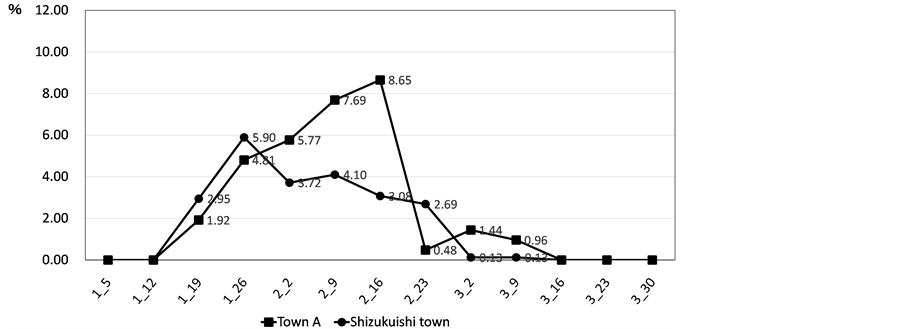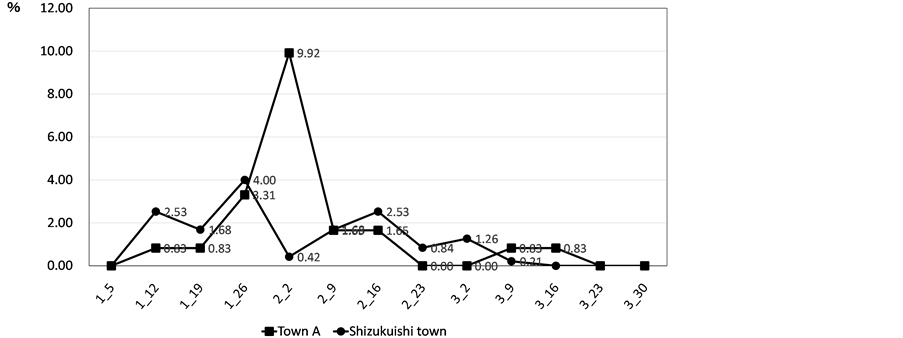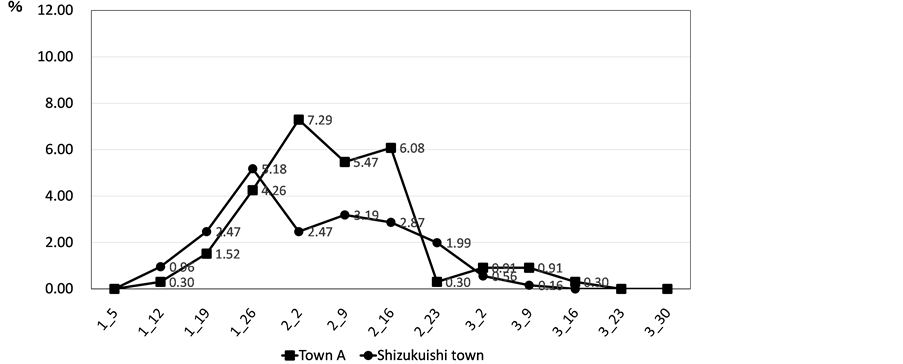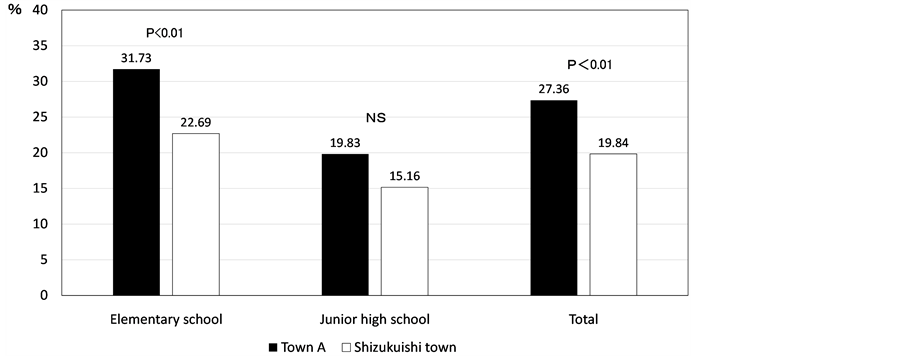Health
Vol.09 No.04(2017), Article ID:75999,7 pages
10.4236/health.2017.94054
Preventive Effect of Lactococcus lactis subsp. lactis JCM 5805 Yogurt Intake on Influenza Infection among Schoolchildren
Kiyomi Sakata1, Yumie Sasaki1, Kenta Jounai2, Toshio Fujii3, Daisuke Fujiwara3
1Department of Hygiene and Preventive Medicine, Iwate Medical University School of Medicine, 2-1-1 Nishitokuta, Yahaba-cho, Shiwa-gun, Iwate, Japan
2Technical Development Center, Koiwai Dairy Products Co., Ltd., 1254 Kamihirose, Sayama-shi, Saitama, Japan
3Central Laboratories for Key Technologies, Kirin Co., Ltd., 1-13-5 Fukuura Kanazawa-ku, Yokohama, Japan

Copyright © 2017 by authors and Scientific Research Publishing Inc.
This work is licensed under the Creative Commons Attribution International License (CC BY 4.0).
http://creativecommons.org/licenses/by/4.0/



Received: March 23, 2017; Accepted: April 27, 2017; Published: April 30, 2017
ABSTRACT
Objective: A community-based intervention study was conducted to examine the effect of consumption of JCM 5805 yogurt on influenza incidence rates and the cumulative incidence rates among schoolchildren in Iwate Prefecture, Japan. Methods: Schoolchildren and their parents in Shizukuishi town were told of the purpose, frequency and duration of JCM 5805 yogurt administration. The number of elementary schoolchildren in Shizukuishi town was 780 while that of junior high school students in Shizukuishi town numbered 475. The number of elementary schoolchildren in neighboring town A was 208 and that of junior high school students in town A was 121. JCM 5805 yogurt was delivered three times a week to all elementary schools and junior high schools in Shizukuishi town from January 16 through March 18, 2015. The incidence rate was calculated every week as the maximum case number divided by the number of schoolchildren in each school. The cumulative incidence rate was calculated as the total case number during the period when JCM 5805 yogurt was delivered divided by the number of schoolchildren in each school. Results: JCM 5805 yogurt intake was associated with a two-thirds reduction in influenza incidence rates in Shizukuishi town schoolchildren compared with those of town A. Furthermore, the cumulative incidence rates of the elementary school and combined data from the elementary school and junior high school were significantly lower than those of neighbor town A. Conclusion: JCM 5805 yogurt intake reduced both the incidence rates and cumulative incidence rates of influenza.
Keywords:
Lactococcus lactis JCM 5805, Plasmacytoid Dendritic Cells, Influenza, Interferon-α, Yogurt

1. Introduction
Diverse immunomodulatory effects of lactic acid bacteria (LAB) and bifidobacteria have been reported for many years [1] . Recently Lactococcus lactis JCM 5805 (L. lactis JCM 5805) was shown to be a unique LAB strain which has a significant impact on murine plasmacytoid dendritic cells (pDC) that regulate both innate and acquired immunity in response to viral infection in vitro and in vivo. Oral administration of L. lactis JCM 5805 induced significant activation of pDC resident in the intestinal draining mesenteric lymph node through DNA from L. lactis JCM 5805 [2] . JCM 5805-fed mice showed a drastic improvement in survival rate, prevention of weight loss, and reduction in lung histopathology scores compared to control mice in a model of parainfluenza virus infection [3] .
The oral administration of L. lactis JCM 5805 significantly decreased the symptoms of influenza-like illness, such as “cough” and “febrile illness” in humans [4] . This study was a randomized placebo-controlled double-blind study to examine the effects of oral intake of JCM 5805 on the pathogenesis of influenza- like illness and response against influenza virus. In addition, peripheral blood mononuclear cells prepared from volunteers were cultured in the presence of inactivated human influenza virus A/H1N1 (A/PR/8/34). Interferon (IFN)-α elicited by A/H1N1 tended to be higher in the JCM 5805 group compared with the placebo group, and an IFN-α-inducible antiviral factor, interferon-stimulated gene 15 (ISG15), elicited by A/H1N1 was significantly higher in the JCM 5805 group compared with the placebo group. L. lactis JCM 5805 also has the ability to enhance the activity of natural killer (NK) cells through plasmacytoid dendritic cell (pDC) activation [5] .
This study was the first community-based intervention study to examine the effects of consumption of JCM 5805 on the reduction of influenza incidence rates and cumulative incidence rates among schoolchildren in Iwate Prefecture. The study was carried out in order to clarify the preventive effects of JCM 5805 yogurt against influenza in a community-based setting.
2. Method
2.1. Study Period and Study Subjects
The authors carried out the study from January through March 2015. Schoolchildren and their parents in Shizukuishi town were told the purpose, frequency and period of delivering JCM 5805 yogurt. They were offered the right not to take part in the study, and details of a contact person for emergencies and inquiries were also collected. Of 1255 schoolchildren in Shizukuishi town, 780 were elementary schoolchildren and 475 were junior high school students. Schoolchildren with milk hypersensitivity would have been excluded, but none had this condition.
Originally, the authors planned to compare the incidence and cumulative incidence of influenza among schoolchildren in Shizukuishi town with children from all seven neighboring municipalities. However, six municipality schools were partly or completely closed before the observation period (Table 1). There- fore, we decided to compare Shizukuishi town with town A, where no elementary schools or junior high schools were partly or totally closed before the observation period. In town A there were 208 elementary schoolchildren and 121 junior high school students.
This study was approved by the ethics committee of Iwate Medical University School of Medicine and the ethics committee of Kirin Holdings Co., Ltd (approval number: 2014-012). All procedures performed in studies involving human participants were in accordance with the ethical standards of the institutional and/or national research committee and with the 1964 Helsinki declaration, and its later amendments or comparable ethical standards.
2.2. Delivery Method and Delivery Period
The test sample was commercially available yogurt made with JCM 5805. One pack of yogurt contains 100 billion cells of L. lactis JCM 5805. JCM 5805 yogurt was delivered three times a week (Monday, Wednesday, and Friday) to all elementary schools and junior high schools in Shizukuishi town from January 16 through March 18, 2015.
2.3. Diagnosis of Influenza
Enforcement regulations for the School Health and Safety Act require schools to inform the Board of Education of the municipality of the number of influenza cases every day. Therefore, the Board of Education of the municipality has a true handle on the exact number of influenza cases in each elementary school or junior high school at any given point. The number of influenza cases in each
Table 1. The number of classes, grades, and schools closed due to influenza in Shizukuishi town and seven neighboring municipalities from November 17, 2014 through January 15, 2015.
school was used as the numerator for influenza infection each day. The incidence rate was calculated as follows:

The cumulative incidence rate was calculated as follows:

The chi-square test was used to test the statistical significance of cumulative incidence rates between Shizukuishi town and town A.
3. Results
First, we evaluated the incidence rates in the elementary school in Shizukuishi town and town A from the week of January 5 through to the week of March 30, 2015. The peak incidence rate of influenza in Shizukuishi town was 5.90% and that for town A was 8.65% (Figure 1). The influenza incidence rates for the junior high school in Shizukuishi town and town A are shown in Figure 2. The
Figure 1. Incidence rates for elementary school in Shizukuishi town and town A from January 5 week through March 30 week, 2015.
Figure 2. Incidence rates for junior high school in Shizukuishi town and town A from January 5 week through March 30 week, 2015.
peak incidence rate in Shizukuishi town was 4.00% and in town A was 9.92%. The combined incidence rates for both elementary school and junior high school are shown in Figure 3. The peak influenza incidence rate for Shizukuishi town was 5.18% and for town A was 7.29%.
The cumulative incidence rates for elementary school, junior high school, and combined data from the week of January 12 through to the week of March 16 are shown in Figure 4. The cumulative incidence rate for the elementary school in Shizukuishi town was 22.69% and that of town A was 31.73%. The cumulative incidence rate for the junior high school in Shizukuishi town was 15.16% and that of town A was 19.83%. The combined cumulative incidence rate for the elementary school and junior high school in Shizukuishi town was 19.84% and that of town A was 27.36%. Since JCM 5805 yogurt was delivered from January 16 through March 18, the cumulative incidence rates were observed for this period. Although the difference in cumulative incidence rates between Shizukuishi town and town A among junior high school students was not statistically signif-
Figure 3. Incidence rates for elementary school and junior high school in Shizukuishi town and town A from January 5 week through March 30 week, 2015.
Figure 4. Cumulative incidence rates for schoolchildren in Shizukuishi town and town A from January 12 week through March 16 week, 2015.
icant, the differences of rates between both elementary school and total schoolchildren were significant at the 1% level.
4. Discussion
We previously revealed that intake of JCM 5805 can activate murine pDC as well as human pDC, both in vitro and in vivo [6] . The results of that study indicated that JCM 5805 yogurt intake three times a week was associated with a reduction of approximately two-thirds in the incidence rates of influenza in schoolchildren. The cumulative incidence rates for elementary school and total schoolchildren in Shizukuishi town were significantly lower than those of the neighboring town A. These results imply that intake of JCM 5805 yogurt among schoolchildren possibly activates pDC, promotes IFN-α production, enhances the cytotoxic activity of NK cells, and has potent antiviral effects. Oral administration of JCM5805 for 10 weeks has previously been demonstrated to prevent the pathogenesis of an influenza-like illness via enhancement of an ISG15-me- diated response to influenza virus [4] . ISG15 inhibits replication and release of influenza virus and type I herpes simplex virus from infected cells [7] . This study revealed for the first time the immunological possibility of reducing influenza epidemics. Such influenza epidemics are of particular concern among students preparing for examinations.
The report by the National Institute of Infectious Diseases as of March 22, 2017 showed that influenza 2009 pandemic A (H1N1) pdm09 viruses were screened during the 2016/2017 season in Japan. Out of 107 viral isolates, 2 isolates (1.9%) showed drug resistance to Oseltamivir and Peramivir [8] . From a total of 85 different viral isolates selected, all showed drug resistance to Amantadine. Of 276 viruses selected, no viral isolates showed resistance to Zanamivir or Laninamivir. In Japan, anti-influenza agents have been used more frequently compared with other countries [9] . JCM 5805 yogurt has an advantage in that it prevents the emergence of drug resistance, if the yogurt can contribute to a reduction in the amount of antiviral agent used.
Our study had certain limitations. First, the incidence rate data was not based on the individual’s history but was based on the reports by enforcement regulations through the School Health and Safety Act. In Japan, schoolchildren infected with influenza visit clinics or hospitals and are given a medical certificate. The school principal will judge if the student should be absent or not based on the certificate. Therefore, it could be that the clinical diagnosis is different from the actual infection. Inclusion of laboratory-confirmed influenza data would provide more firm evidence of the effect of JCM 5805 yogurt. Second, since we could not obtain individual histories of vaccination, we could not eliminate the effects of vaccination. The incidence of influenza will also be affected by temperature, humidity, stress, and many other environmental factors. In this study we could not eliminate the effects of these factors. Further studies are needed to clarify the specific effects of JCM 5805 yogurt.
5. Conclusion
JCM 5805 yogurt intake three times a week over a 3-month period reduced the incidence rates of influenza by approximately two-thirds in Shizukuishi town schoolchildren compared with those of the neighboring town. Furthermore, the cumulative elementary school incidence rates and combined elementary school and junior high school data were significantly lower compared with those of town A.
Acknowledgements
We would like to express our deepest appreciation to the schoolchildren and their parents in Shizukuishi town and the Board of Education in Shizukuishi town and the Board of Education in each of the neighboring municipalities.
Cite this paper
Sakata, K., Sasaki, Y., Jounai, K., Fujii, T. and Fujiwara, D. (2017) Preventive Effect of Lactococcus lactis subsp. lactis JCM 5805 Yogurt Intake on Influenza Infection among Schoolchildren. Health, 9, 756-762. https://doi.org/10.4236/health.2017.94054
References
- 1. Fontana, L., Bermudez-Brito, M., Plaza-Diaz, J., Muñoz-Quezada, S. and Gil, A. (2013) Sources, Isolation, Characterisation and Evaluation of Probiotics. British Journal of Nutrition, 109, s35-s50.
https://doi.org/10.1017/s0007114512004011 - 2. Jounai, K., Ikado, K., Sugimura, T., Ano, Y., Braun, J. and Fujiwara, D. (2012) Spherical Lactic Acid Bacteria Activate Plasmacytoid Dendritic Cells Immunomodulatory Function via TLR9-Dependent Crosstalk with Myeloid Dendritic Cells. PLOS ONE, 7, e32588.
https://doi.org/10.1371/journal.pone.0032588 - 3. Jounai, K., Sugimura, T., Ohshio, K. and Fujiwara, D. (2015) Oral Administration of Lactococcus Lactis Subsp. Lactis JCM 5805 Enhances Lung Immune Response Resulting in Protection from Murine Parainfluenza Virus Infection. PLOS ONE, 10, e0119055.
https://doi.org/10.1371/journal.pone.0119055 - 4. Sugimura, T., Takahashi, H., Jounai, K., Ohshio, K., Kanayama, M., Tazumi, K., et al. (2015) Effects of Oral Intake of Plasmacytoid Dendritic Cells-Stimulative Lactic Acid Bacterial Strain on Pathogenesis of Influenza-Like Illness and Immunological Response to Influenza Virus. British Journal of Nutrition, 114, 727-733.
https://doi.org/10.1017/S0007114515002408 - 5. Suzuki, H., Ohshio, K. andFujiwara, D. (2016) Lactococcus Lactis subsp. Lactis JCM 5805 Activates Natural Killer Cells via Dendritic Cells. Bioscience, Biotechnology, and Biochemistry, 80, 798-800.
https://doi.org/10.1080/09168451.2015.1116922 - 6. Sugimura, T., Jounai, K., Ohshio, K., Tanaka, T., Suwa, M. and Fujiwara, D. (2013) Immunomodulatory Effect of Lactococcus Lactis JCM 5805 on Human Plasmacytoid Dendritic Cells. Clinical Immunology, 149, 509-518.
https://doi.org/10.1016/j.clim.2013.10.007 - 7. Lenschow, D.J., Lai, C., Frias-Staheli, N., Giannakopoulos, N.V., Lutz, A., Wolf, T., et al. (2007) IFN-Stimulated Gene 15 Functions as a Critical Antiviral Molecule against Influenza, Herpes, and Sindbis Viruses. Proceedings of the National Academy of Sciences of the United States of America, 104, 1371-1376.
https://doi.org/10.1073/pnas.0607038104 - 8. National Institute of Infectious Diseases. (2017) Antiviral Resistance Surveillance in Japan.
http://www.niid.go.jp/niid/en/influ-resist-e/7239-flu-r-e20170426.html - 9. Tashiro, M., McKimm-Breschkin, J.L., Saito, T., Klimov, A., Macken, C., Zambon, M., et al. (2009) Surveillance for Neuraminidase-Inhibitor-Resistant Influenza Viruses in Japan, 1996-2007. Antiviral Therapy, 14, 751-761.
https://doi.org/10.3851/IMP1194






